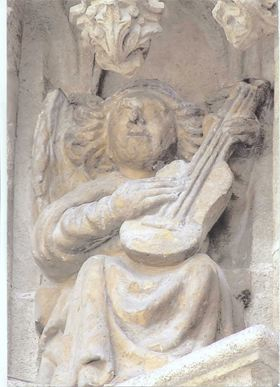Angel musician with three-string vihuela or guitar. Lorenzo Mercadante de Bretaña, 1464-1467
(1467) - Seville cathedral, Portada del Nacimiento.
instrument: vihuela | century: 15cent/2/mid | catalogue nº: 15-213

Artwork
Creator Mercadante de Bretaña, Lorenzo
Medium Artwork: Sculpture
Location
City Sevilla | Region Andalucia | Old kingdom Castile
Characteristics
| Body Waisted | Strings 3 strings | Neck Medium | Pegbox None |
| Bridge Fixed | Frets No | Back Flat | Pegs None |
| Technique Plucked fingers |
Commentary
ARTWORK
Portada del Nacimiento, Seville catedral. The doorway is located on the western facade, at the right end . The sculpture is made of baked clay and polychrome, painted in ochre in 1792 and restored in 1912. Current condition is poor condition as a result of weathering and pollution. The iconographic theme of the portal is the Nativity. Mary and Joseph adore the Child while surrounded by angels singing and playing musical instruments: nakkers, drum, double flute, five-course lute played with a plectrum and this vihuela/guitar. The artwork is described in detail by Carlos González (gonzalez2006). Its artist was French and many of its details betray foreign origin,
INSTRUMENT
González suggests this vihuela might represent the “missing link” between the medieval guitarra (3 course of double or triple strings) and the 4-course guitar of the 16th century. He suggests that this instrument might represent an early example of the type of vihuela that later became called “guitarra”, together with an instrument in Burgo de Osma (16-156) and the instruments in the carved bas-relief in the castle in Vélez-Blanco in Almería (16-146). Also see 15-214 and 15-215. The instrument is small in size, held almost vertically and played with the fingers of the right hand, not a plectrum. The soundbox has incurved waists and a shallow body, probably originallly carved from one piece of wood. The neck is in correct proportion to fit 8 or 9 frets and the pegbox is lute style, although at a lesser angle than the lutes, it apparently has no pegs. The three courses of strings are clearly visible,